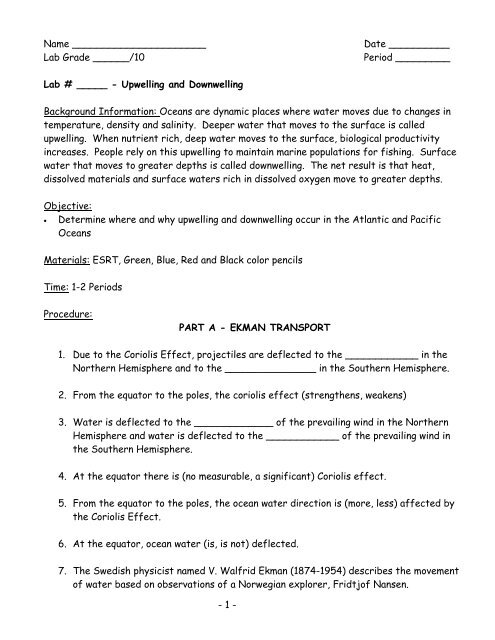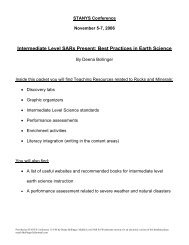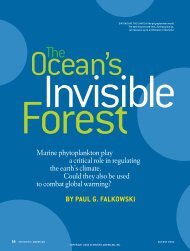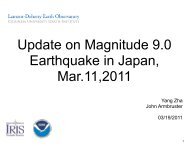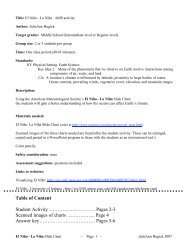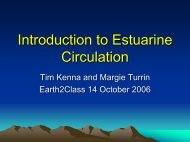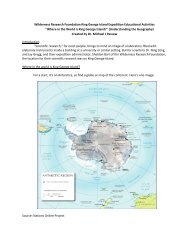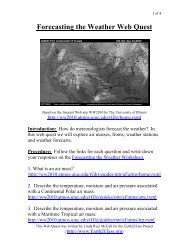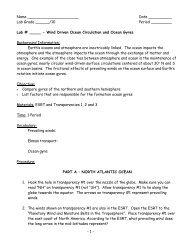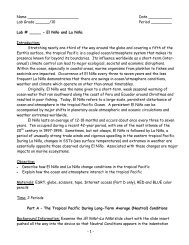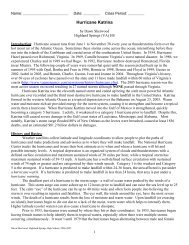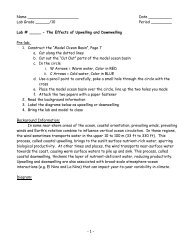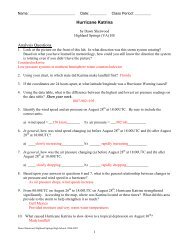Upwelling and Downwelling
Upwelling and Downwelling
Upwelling and Downwelling
Create successful ePaper yourself
Turn your PDF publications into a flip-book with our unique Google optimized e-Paper software.
Name ______________________<br />
Lab Grade ______/10<br />
Date __________<br />
Period _________<br />
Lab # _____ - <strong>Upwelling</strong> <strong>and</strong> <strong>Downwelling</strong><br />
Background Information: Oceans are dynamic places where water moves due to changes in<br />
temperature, density <strong>and</strong> salinity. Deeper water that moves to the surface is called<br />
upwelling. When nutrient rich, deep water moves to the surface, biological productivity<br />
increases. People rely on this upwelling to maintain marine populations for fishing. Surface<br />
water that moves to greater depths is called downwelling. The net result is that heat,<br />
dissolved materials <strong>and</strong> surface waters rich in dissolved oxygen move to greater depths.<br />
Objective:<br />
• Determine where <strong>and</strong> why upwelling <strong>and</strong> downwelling occur in the Atlantic <strong>and</strong> Pacific<br />
Oceans<br />
Materials: ESRT, Green, Blue, Red <strong>and</strong> Black color pencils<br />
Time: 1-2 Periods<br />
Procedure:<br />
PART A - EKMAN TRANSPORT<br />
1. Due to the Coriolis Effect, projectiles are deflected to the ____________ in the<br />
Northern Hemisphere <strong>and</strong> to the _______________ in the Southern Hemisphere.<br />
2. From the equator to the poles, the coriolis effect (strengthens, weakens)<br />
3. Water is deflected to the _____________ of the prevailing wind in the Northern<br />
Hemisphere <strong>and</strong> water is deflected to the ____________ of the prevailing wind in<br />
the Southern Hemisphere.<br />
4. At the equator there is (no measurable, a significant) Coriolis effect.<br />
5. From the equator to the poles, the ocean water direction is (more, less) affected by<br />
the Coriolis Effect.<br />
6. At the equator, ocean water (is, is not) deflected.<br />
7. The Swedish physicist named V. Walfrid Ekman (1874-1954) describes the movement<br />
of water based on observations of a Norwegian explorer, Fridtjof Nansen.<br />
- 1 -
8. Ekman determined that ocean water is deflected 45° to the direction of the prevailing<br />
wind in the Northern <strong>and</strong> Southern Hemispheres. Draw this angle <strong>and</strong> label it<br />
“Surface Layer” in the diagram below. Also, Ekman determined that water is<br />
transported at 90° from the prevailing wind direction in the Northern <strong>and</strong> Southern<br />
Hemispheres. Draw this angle <strong>and</strong> label it “Net Water Movement”.<br />
WIND<br />
9. Open the ESRT to the Surface Ocean Currents. Color the continents GREEN.<br />
10. Use a pencil to draw the following latitudes <strong>and</strong> label each latitude on the left side of<br />
the page: 0°, 30° N <strong>and</strong> S, 60° N <strong>and</strong> S <strong>and</strong> 90° N <strong>and</strong> S.<br />
PART B - NORTHERN HEMISPHERE<br />
11. Open the ESRT to the Planetary Wind <strong>and</strong> Moisture Belts in the Troposphere.<br />
Between what latitudes do the prevailing westerlies move? __________________<br />
Use a RED color pencil to draw the prevailing westerlies on the map of Surface Ocean<br />
Currents. Include as one of the arrows, a RED arrow over the Gulf Stream (Gulf<br />
Stream Wind Arrow).<br />
12. To illustrate the “Net Water Movement”, use a BLACK color pencil to draw an arrow<br />
90° to the Gulf Stream Wind Arrow. Remember: Deflection is to the _______ in the<br />
Northern Hemisphere.<br />
13. According to the ESRT - Planetary Wind <strong>and</strong> Moisture Belts in the Troposphere,<br />
between what latitudes do the trade winds move? _________________________<br />
Use a BLUE color pencil to draw the trade winds on the map of Surface Ocean<br />
Currents. Include as one of the arrows, a BLUE arrow over the North Equatorial<br />
Current (N.E.C. Wind Arrow).<br />
14. To illustrate the “Net Water Movement”, use a BLACK color pencil to draw an arrow<br />
90° to the N.E. C. Wind Arrow. Remember: Deflection is to the _______ in the<br />
Northern Hemisphere.<br />
15. The two black arrows are pointing (toward, away from) each other at 30°N.<br />
- 2 -
16. There is a (mounding, depression) of ocean water at 30°N. Think of this as a hill that<br />
water must move down but as it moves down the water is deflected to the (right,<br />
left). This result in the (clockwise, counterclockwise) movement of gyres in the<br />
Northern Hemisphere.<br />
17. Ocean water moves (toward, away from) the East Coast of North America.<br />
18. Water moves (up to the surface, to greater depths) to replace the moved surface<br />
water.<br />
19. (<strong>Upwelling</strong>, <strong>Downwelling</strong>) occurs along the East Coast of the USA.<br />
PART C - SOUTHERN HEMISPHERE<br />
20. Now lets focus our attention on the Southern Hemisphere. According to the ESRT -<br />
Planetary Wind <strong>and</strong> Moisture Belts in the Troposphere, between what latitudes do the<br />
southwesterlies move? _________________________ Use a BLUE color pencil to<br />
draw the southwesterlies on the map of Surface Ocean Currents.<br />
21. According to the ESRT - Planetary Wind <strong>and</strong> Moisture Belts in the Troposphere,<br />
between what latitudes do the northeasterlies move? _______________________<br />
Use a RED color pencil to draw the northeasterlies on the map of Surface Ocean<br />
Currents.<br />
22. Deflection is to the _________ in the Southern Hemisphere.<br />
23. Use a BLACK color pencil to draw arrows that illustrate the 90° of the “Net Water<br />
Movement” of the Brazil <strong>and</strong> Benguela Currents.<br />
24. There is a (mounding, depression) of ocean water at 30°S. Think of this as a hill that<br />
water must move down but as it moves down the water is deflected to the (right,<br />
left). This result in the (clockwise, counterclockwise) movement of gyres in the<br />
Southern Hemisphere.<br />
25. Use a black pencil to draw the “Net Water Movement” along the Peru Current.<br />
26. Ocean water moves (toward, away) from the East Coast of South America.<br />
27. Water moves (up to the surface, to greater depths) to replace the moved surface<br />
water.<br />
- 3 -
28. (<strong>Upwelling</strong>, <strong>Downwelling</strong>) occurs along the East Coast of South America.<br />
29. According to the ESRT, the winds along the equator move from the (west to east, east<br />
to west).<br />
30. Warmer waters accumulate in the (western, eastern) Pacific Ocean.<br />
31. More evaporation of ocean water occurs in the (western, eastern) Pacific Ocean.<br />
32. Low pressure develops in the (western, eastern) Pacific Ocean.<br />
33. There is more precipitation in the (western, eastern) Pacific Ocean.<br />
34. The eastern Pacific Ocean is (wetter, drier) than the western Pacific Ocean.<br />
35. Label the Western <strong>and</strong> Eastern Pacific Ocean as: high or low pressure <strong>and</strong> wet or dry.<br />
Source: New York State, Earth Science Reference Tables 2001<br />
36. During an El Nino episode, the high <strong>and</strong> low pressure of the Pacific weakens. The<br />
east to west winds (strengthen, weaken).<br />
37. The wind direction moves from the west to the ___________.<br />
38. Warmer equatorial waters move from the _____________ to the ___________.<br />
39. Water moves (toward, away from) the West coast of South America.<br />
40. Water accumulates <strong>and</strong> sinks along the west coast of South America. This<br />
(strengthens, weakens) upwelling along the West coast of South America.<br />
- 4 -
41. Nutrient levels (increase, decrease) along the West coast of South America.<br />
42. Biological productivity (increase, decrease) along the West coast of South America.<br />
43. During a La Nino episode, the normal high <strong>and</strong> low pressure systems of the Pacific<br />
strengthen. The east to west winds (strengthen, weaken).<br />
44. During a La Nina episode, the Peru Current (weakens, strengthens).<br />
45. There is a net movement of ocean water (toward, away from) South America.<br />
46. (<strong>Upwelling</strong>, <strong>Downwelling</strong>) occurs along the coast of South America.<br />
Summary of Data:<br />
Hemisphere Deflection<br />
Latitude of<br />
Ocean Water<br />
Mounding<br />
Gyre Direction<br />
(Clockwise or<br />
Counterclockwise)<br />
<strong>Upwelling</strong><br />
(West or<br />
East Coast)<br />
<strong>Downwelling</strong><br />
(West or East<br />
Coast)<br />
Northern<br />
Southern<br />
47. For each diagram below, use the following terms with an arrow where appropriate: Net<br />
transport, <strong>Downwelling</strong>, <strong>Upwelling</strong><br />
Southern<br />
Hemisphere<br />
48. <strong>Upwelling</strong> or <strong>Downwelling</strong>? ____________________________<br />
49. Example of Coast __________________________________<br />
- 5 -
Northern<br />
Hemisphere<br />
50. <strong>Upwelling</strong> or <strong>Downwelling</strong>? ____________________________<br />
51. Example of Coast ___________________________________<br />
PART D - INTERNET RESOURCES<br />
52. Now you will go to a website that discusses ocean currents. Go to<br />
http://oceancurrents.rsmas.miami.edu/<br />
53. Click on the Atlantic Ocean on the world map or click on “Atlantic Ocean Currents”.<br />
Click on “Name/Location”.<br />
54. Move your cursor over the Atlantic Ocean to find the following currents: Gulf<br />
Stream, Brazil <strong>and</strong> Benguela.<br />
55. At the top of the page click on “Pacific”. If the website has completed this part of<br />
the web page, then locate the Peru Current.<br />
56. Go to http://podaac-www.jpl.nasa.gov/ost/. Click on the image to enlarge it.<br />
57. Next we will view a map that shows sea surface height above the mean sea surface in<br />
______________.<br />
58. What does red, orange <strong>and</strong> yellow represent on the map?<br />
59. What is a positive sea surface height?<br />
60. What does blue <strong>and</strong> purple represent on the map?<br />
61. What is a negative sea surface height?<br />
62. Approximately what is the highest sea surface height above the mean sea surface?<br />
- 6 -
63. Convert the mm value to cm. ________________<br />
64. In the box below draw a line of the length in the question above.<br />
65. Approximately what is the lowest sea surface height below the mean sea surface?<br />
66. According to the image, sea levels are generally (high, low) in subtropical portions of<br />
the ocean basins.<br />
67. These locations have (mounds, depressions) of water as identified earlier in this<br />
investigation. Note that factors in addition to Ekman transport affect the dynamic<br />
topography of the ocean surface. One factor is water expansion due to increased<br />
temperature as found in the western Tropical Pacific.<br />
Conclusion: (Answer in complete sentences)<br />
68. How does the occurrence of an El Nino affect ocean circulation <strong>and</strong> biological<br />
productivity?<br />
69. How does the occurrence of a La Nina affect ocean circulation <strong>and</strong> biological<br />
productivity?<br />
This laboratory investigation was modified from<br />
DataStreme Ocean Benchmark Investigation 6A<br />
Wind-Driven Ocean Circulation<br />
- 7 -


